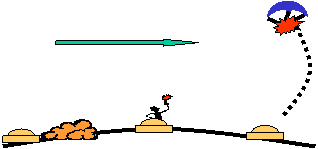Marine Distress Flares
Flares
Flares have two purposes, to attract attention over a long distance and to pinpoint the vessel in trouble.
The use of distress flares indicates that there is grave and imminent danger to life or a vessel. As such, they should only be used on the instructions of the skipper.
• Handheld Red
This type of flare is visible up to about three miles in daylight or at night. They should only be used if you can see land, a boat or an airplane, if you can not see them, no one can see you!
If you can not see anything, a parachute flare could be used, then the handheld ones used when a potential rescue craft or airplane is in sight.
Some skippers keep a tough glove in the flare box to protect their hand from the heat and burning material that can fall off a burning flare.
• Orange Smoke
These may be hand held or floating, both have a range of one to three miles and can only be used in daylight when you can see a potential rescuer.
Because the smoke disperses quickly, try to fire a smoke flare in a sheltered area, if it is operated from the downwind side of the vessel, the smoke will tend to cling to the boat because of the turbulent air flow around the vessel.
Handheld flares tend to last for about 40 seconds and floating orange smoke for about 3 minutes.
• Red Parachute
Parachute flares are rockets, which rise to about 300 metres, then drift down with a bright red light on a parachute. Because of the height these flares can be see up to 25 miles away, but only if the weather is clear enough.

When you fire a parachute flare it will turn in to the wind slightly, so they should be fired about 10-15 degrees downwind of the vertical. They will then fly straight up.
When you fire a parachute flare, fire two at about five minute intervals. If the first one is seen by a watch-keeper on a ship, this will allow enough time for the skipper to be alerted and to see the second one for himself. You are much more likely to be picked up if you follow this pattern.
Recommended number of flares
Inshore5 miles from land |
Coastal7 miles from land |
OffshoreOver 7 miles from land |
2 hand held red 2 orange smoke |
2 hand held red 2 orange smoke 2 parachute red |
6 hand held red 2 buoyant orange smoke 4 parachute red |
• White Flares
White flares are not distress flares. A hand held one can be used to indicate your presence to a ship if there is a risk of collision.
White parachute flares have been used for illumination at night in the case of a man over board. Launching a series of white parachute flares can keep an area illuminated whilst you search for a casualty, you may find that they destroy your night vision.
It may be worth carrying white flares for these rare occasions but they must be stored apart from those used for indicating distress.
Life span
Typically flares have a three year life, after this time they should be disposed of, this is normally arranged by the place you purchased them, so when you replace your out of date flares, you should be able to return the old ones at the same time. You may be able to leave them at some Coastguard or Lifeboat stations or occasionally with your harbour master, although all three of these are less keen to do this than in the past due to changes in Health and Safety law.
The disposal date is written on the side of a flare, and whilst they may still work after this time there is a risk that they may misfire. I have seen old parachute flares come out of the side of the tube when operated and hand held flares burn from close to the handle rather than the safe end.
Practice
There are several different systems used to operate a flare, you need to be familiar with those on your vessel, and ideally to have attended a flare demonstration. Normally you will get the chance to fire off hand held flares but not parachute ones.
It can be surprisingly hard to ignite some hand held flares as they require quite a sharp blow to the base to work, this can be achieved by banging them on the deck of the vessel if you are not strong enough to do it by hand.
This sort of practice can occasionally be organised by a yacht club. Remember that it is illegal to fire distress flares if you are not in distress. It may be possible to do so at a training session, but this will normally only be with handheld flares is a position where they can not be confused with a real emergency. Parachute flares are designed to burn for as long as possible and to land in water, which extinguishes them. If you fire one inland at a firework display, unlike a firework rocket, it will still be burning when it lands, pretty serious if it lands on a thatched roof! There was an incident on November 5 2007 in the River Itchen, where a burning flare landed in the cockpit of a vessel and nearly caused a serious incident before the crew were able to extinguish the flames.
Hansson Icarus are one of the biggest distributors of distress flares for the marine market. Flares can be purchased individually or in ready made up packs.
Sailtrain.co.uk is free to use, but if you feel you would like to contribute to the running and development costs you can donate via Paypal:
Additional Resources:

